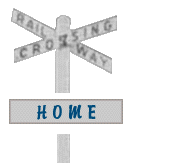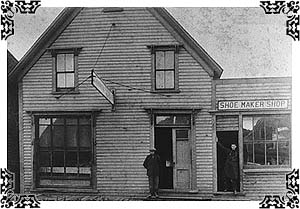








 Until
the mid-1800s, shoemaking involved only the use of simple
hand tools-- an awl, hammer and nails, and needle and
thread. Most of the population wore either homemade shoes
or bought hand-fashioned shoes from a shoemaker. The
shoemaker would travel door-to-door, making house calls
to fit people for new shoes. In 1841, Thomas Larkin
became the first shoemaker and repairer in Barrett's
Cross, fixing the shoes of residents and travelers alike
who wore out their soles while walking the rough
cart-paths.
Until
the mid-1800s, shoemaking involved only the use of simple
hand tools-- an awl, hammer and nails, and needle and
thread. Most of the population wore either homemade shoes
or bought hand-fashioned shoes from a shoemaker. The
shoemaker would travel door-to-door, making house calls
to fit people for new shoes. In 1841, Thomas Larkin
became the first shoemaker and repairer in Barrett's
Cross, fixing the shoes of residents and travelers alike
who wore out their soles while walking the rough
cart-paths.
It was at roughly this same time that the shoe industry in the urban areas of the U.S. and central Canada started to become increasingly mechanized. More and more, shoe making became a factory operation, where a machine would rapidly stitch together shoe components that would have previously required nailing and sewing. The price of shoes decreased and the general public was eager to purchase many different types of shoes, rather than a single serviceable pair. No shoemaker, no matter how swift, could make shoes at a comparable rate or at a competitive price. By the early 1900's, mass production had almost completely overtaken the craft of shoemaking.
Although the need for shoemakers decreased, there was a new need for shoe stores to display and sell the factory wares. William Lawson and James Warren both had shoe stores in Kensington, featuring a wide selection for both the fashion-conscious and the more practical-minded, rubber boots for local farmers and patent leather for Sunday dress. Although there are no longer any shoe stores in Kensington, Stedman's department store still has a selection of shoes that can be purchased.
Blacksmith | Tailor and Dressmaker | Livery Stable | Herbert R. Moase, Tradesman